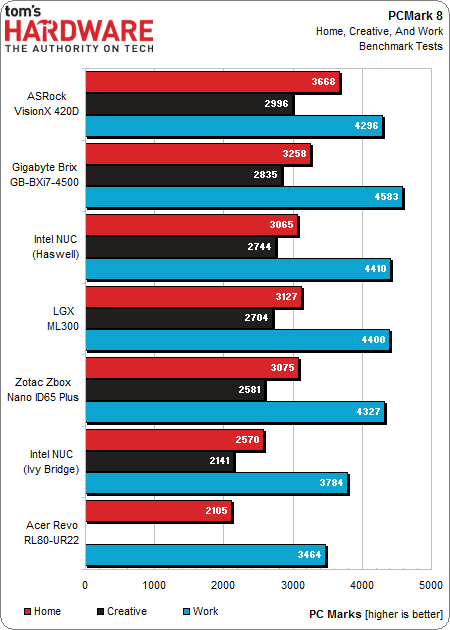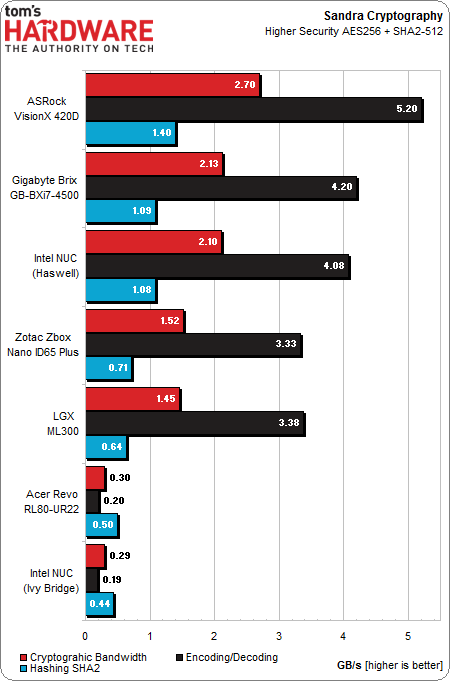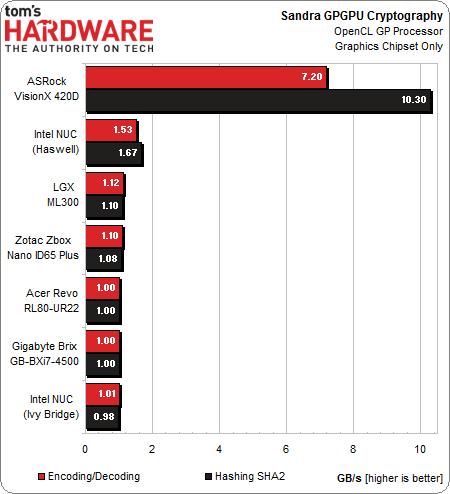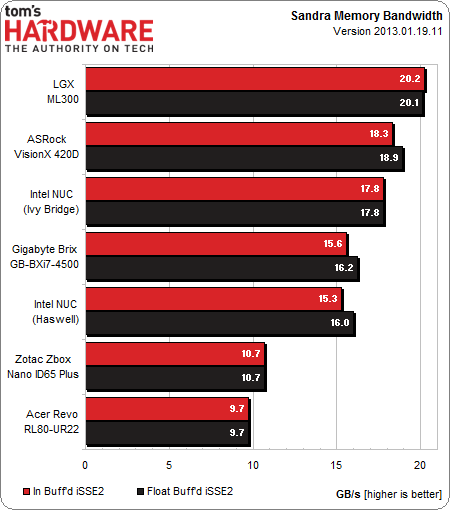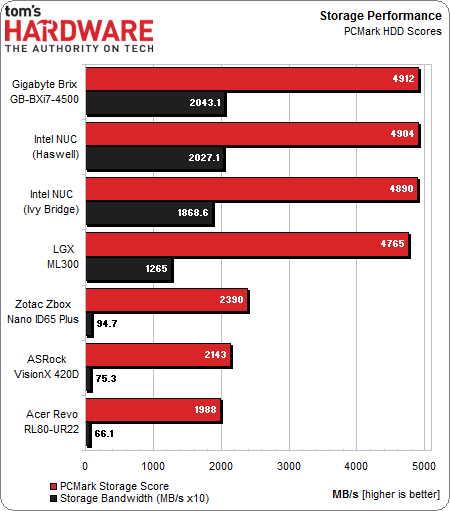Seven Small (But Powerful) Mini-PCs, Reviewed
Synthetic Benchmarks
Why you can trust Tom's Hardware
I capped this chart at 9000 points because the VisionX's graphics score was so high relative to the competition (in excess of 16,000 points) that it made meaningful comparisons difficult. ASRock's system is the only one with a discrete GPU, and it shows.
With a 9000-point ceiling, however, we can identify a few trends. A single-channel memory configuration and low host clock rates push Acer's Revo to the back of the pack. Zotac's Zbox nano ID65 Plus suffers from the same bandwidth bottleneck, but manages to leap ahead of the Ivy Bridge-based NUC thanks to higher clock rates and more shared L3 cache, which bolster the Physics score.
The ML300 and Gigabyte Brix are a bit faster, but Intel's Haswell-based NUC distinguishes itself from the rest of the integrated graphics options with its HD Graphics 5000 GPU.
This PCMark 8 chart is sorted by the Home and Creative results, since the work numbers aren't as consistent with the other two categories.
The Home benchmark suite includes Web surfing, light gaming, photo editing, and video chat, while the Creative module involves more intense photo editing and video transcoding workloads. We'd expect those tasks to favor core count, but since these are all dual-core solutions, the emphasis is on clock rate in threaded applications more so than underlying architecture.
Because of this, the lower-clocked Ivy Bridge-based NUC and Acer Revo struggle compared to the other platforms, which produce similar results. The Work benchmark reflects simple document reading and writing applications, and it's curious to see ASRock's VisionX fall behind. Hard disk access speed might come into play, which would help explain the results.
Acer's Revo suffered a strange repeatable error when it came to the Creative benchmark suite, and was unable to complete it.
SiSoft Sandra's Arithmetic test focuses on integer and floating-point performance. In a line-up of dual-core-based platforms, clock rate is most influential, followed by architectural improvements that introduce enhanced instruction set support.
Case-in-point: the Cryptography benchmark reflects support for AES-NI and lots of memory bandwidth able to feed the x86 cores fresh instructions.
That's not the case for the GPU-based Cryptography test, which is driven by OpenCL performance. ASRock's discrete Radeon chip decimates the competition. The only other solution standing out is Intel's HD Graphics 5000 (GT3) engine, which is faster than the other on-die implementations.
Sandra's Memory Bandwidth module illustrates the bandwidth hit the single-channel solutions take. A second SO-DIMM would solve the problem for Acer's Revo. However, Zotac's Zbox nano ID65 Plus doesn't have another slot to populate.
The rest of the results scale with data rate. Because the Haswell-based Intel NUC and Gigabyte Brix don't work with 1.5 V modules, we had to use the 1.35 V DDR3-1333 memory available to us on those platforms.
The Storage sub-test makes it pretty clear which mini-PCs sport SSDs and which ones employ hard drives. The results come fairly close to each other, though we do see the LGX's Emphase Enterprise 128 GB SSD fall behind Intel's SSD 525 180 GB.
Although the SSDs are very fast, keep in mind that the mechanical disks counter with lower cost per gigabyte and higher capacity.
Current page: Synthetic Benchmarks
Prev Page Test Systems And Benchmarks Next Page Game Benchmarks: Low Detail, 720pGet Tom's Hardware's best news and in-depth reviews, straight to your inbox.
Don Woligroski was a former senior hardware editor for Tom's Hardware. He has covered a wide range of PC hardware topics, including CPUs, GPUs, system building, and emerging technologies.
-
outlw6669 Not a single AMD based SFF PC?Reply
I am disappoint, this would be a great area for AMD to show their competitiveness. -
ta152h @outlw6669I built one based on the A6 5200, and it's perfect for what I need it for. It's low power, more than fast enough for what 99% of the people do, quiet, and inexpensive. I'm a little surprised they didn't choose something based on the Jaguar for that reason, but it might just be a situation where nothing with one was sent to them for review. Certainly this is a poor representation, without both Jaguar and Bay Trail missing. I got to the first page, read what they had, looked at the cases, and moved on. Reading about different versions of Ivy Bridge and Haswell and how they compare to each other is profoundly uninteresting.Reply -
m32 I wouldn't mind having a small system like this. Maybe Mid-Year when everyone's CPU/APUs are out, I'll have the chance to make a smart buy. Thanks for the article. :)Reply -
mesab66 It is interesting that by going slightly larger with the enclosure space (still keeping within cube/rectangle/media player shape) opens up the possibility of so much more power....dedicated gfx, full cpu, etc etc., and, can be cheaper to build - depending on the users requirements.......of course, at the cost of power requirements, etc. I'm thinking most folk would ideally chose a slightly larger form factor for living room/media pc duties.On the other hand, if constraints are tight (form factor in this article) and the end user's requirements match, then these options are worth considering.Reply -
s997863 Power. I don't care about no power. Where's the love for the old games? If I want to play some of the classics which just don't emulate properly, I have to hunt for a heavy old Pentium3 box and try to get it working. How about a cheap mini PC with miniaturized legacy hardware for full compatibility to dual-boot win98 & XP, with gameports, VGA & S-Video, PS/2 & USB, IDE & SATA external ribbon & power connectors, & a turbo button for choosing between 2 processors 200MHz & 3GHz?Reply -
vertexx I am a huge fan of compact systems. Almost everything I have built has been ITX. But I've had a hard time with the NUC form factor. As a desktop, I think it's actually too small. One of those boxes would get lost on my desk, continuously being pushed around by other clutter. Now, if I had a hutch with an optimally sized cubby, that might be a different story.Reply
VESA mounted on the back of a monitor, these look really clunky, and I'd rather go with an AIO kit using the thin mini-ITX form factor where I have more control over processor choice.
I'd be more excited if this technology and form factor were applied in a more interchangeable system with a standardized GPU socket. I really like what ASRock and Gigabyte have done with their compact systems. They're not as compact, but having something a little more substantial on my desk is a good thing, and they pack a lot of punch. I just wish the standards were developed to allow builders to replicate that feat - pipe dream, I know.
One thing is for sure, AMD needs to develop it's own equivalent of the NUC and thin Mini-ITX. The success of it's Kaveri line I think would be helped out by innovation in form factor. -
axehead15 I think you should compare the Mac Mini to these, that way we can see how it adds up.Reply

